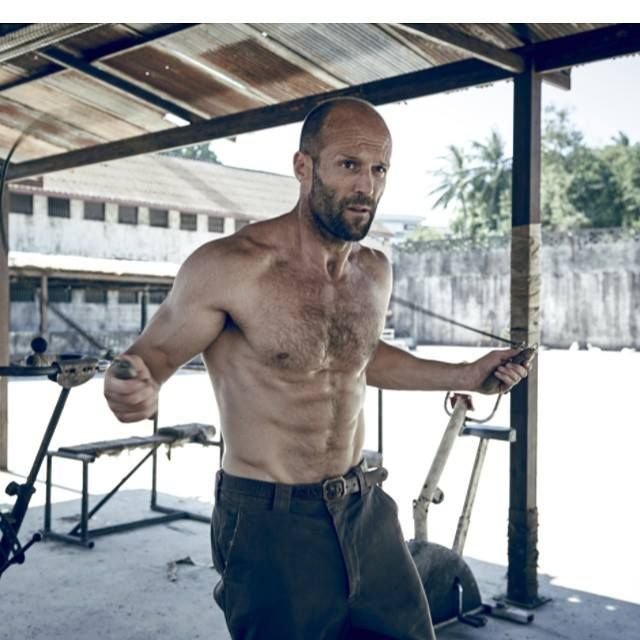The difficult workout to have a physique like Jason Statham
"Hobbs & Shaw" brings together the famous unlikely duo of former enemies Luke Hobbs (Dwayne "The Rock" Johnson) and Deckard Shaw (Jason Statham) to eliminate a genetically modified cyber villain that threatens the world. Actor Jason Statham, who plays Shaw, had to be in great physical shape for the role.
Although he does not have the imposing and monstrous physique of his assistant The Rock, Statham has an incredibly designed and dry physique, with perfectly symmetrical and aesthetic muscle development.
Statham may look small next to The Rock muscle mountain, which measures 1m96 by 118 kg, but still with a size of 1m78 by about 77 kg, it exhibits an impressive, ultra-dry, hard and solid physique.
Jason Statham's training
Day 1: Progression for land survey
The goal of this workout is to develop pure strength in one of the most effective basic exercises for the complete development of the body: soil lifting.
To do this, we must ensure that Jason reaches his 1WD, which is the heaviest load he can lift once. Basically the maximum load.
Heating part 1: rowing machine. Jason starts with 10 minutes of rowing at a rate of about 20 draws per minute and a distance of 2,274 meters.
Warm-up part 2: Pyramid circuit. 3 exercises on the circuit (one series of each chained exercise without rest time). Use a pyramidal repetition structure to train: during the first lap of the circuit, repeat each movement once. Each next turn, make an additional repetition.
Therefore, you will do two repetitions of each exercise in turn 2, three rehearsals in turn 3 and so on. After completing five rounds, continue, but reduce the number of repetitions you complete in each round. Therefore, you will do four rehearsals on lap 6, three repetitions in round 7, and so on, up to a single repetition.
1. Grounding pumps
2. Tractions on the fixed bar
(These are classic tractions, but Jason uses gym rings instead of the bar and performs each repetition as soon as possible, maintaining good technique and a full amplitude.
3. Squat
Jason starts with a light load of about 35% of his 1WD, then slowly begins to add weight and reduce repetition. As the weight approaches his 1WD, which, for Jason, represents more than twice his weight, his rest between sets increases to 3 minutes. This allows for an almost complete recovery between the series.
Jason's training in earth elevation:
Repetitions: 10
Weight: 60 kg
Rest: 1 minute
Repetitions: 5
Weight: 85 kg
Rest: 2 minutes
Essays: 3
Weight: 105 kg
Rest: 3 minutes
Essays: 2
Weight: 130 kg
Rest: 3 minutes
Repetitions: 1
Weight: 150 kg
Rest: 3 minutes
Repetitions: 1
Weight: 155 kg
Rest: 3 minutes
Repetitions: 1
Weight: 160 kg
Rest: 3 minutes
Repetitions: 1
Weight: 162.5 kg
Rest: 3 minutes
Repetitions: 1
Weight: 165 kg
Return to calm, recovery:
10 minutes on the trampoline. Jason uses a size 10×17 gymnastics trampoline for 10 minutes of air work in Freestyle.
Day 2: Functional circuit
This training is designed to be a demanding metabolic activity, training the whole body with exercises that work several muscle groups at the same time.
Heating (Part 1): rowing machine. As on day 1, Jason starts with 10 minutes in the rower at a rate of 20 draws per minute for a distance of 2238 meters.
Heating (Part 2): Static retention circuit. Do these four exercises in the form of a circuit training. For each exercise, you will maintain a specific position in the isometry for 30 seconds and then have 10 seconds to move on to the next exercise. Make four laps in total.
1. Isometric support on the rings
Keep the position upright using gym rings or, failing that, parallel bars or dives. Iron cross position for gymnasts or very advanced.
2. Kettlebell Farmer Hold: Farmer's March
Take a pair of heavy kettlebells or dumbbells and leave your arms hanging next to you and then walk for 100 m.
3. Position of the square on parallel bars or dives
Jason uses parallel bars to perform this exercise, but you can also use the diving chair.
4. Squatting in isometry
Go down to the squat position with your thighs parallel to the floor and hold the position.
Here, Jason performs a circuit of 5 exercises that he performs 10 times in total. There is no rest between the exercises. Focus on the execution speed, maintaining a good technique, in full and controlled amplitude
1. Squat bar at the front (45 kg)
2. Tractions
3. Pumps available with parallel bars or with a special pump handle.
Indications: Hands on the handles, feet on a bench or raised. Make the indicated number of bombs. Generally, as you are lifted thanks to the handles, you can go down lower and have a greater range of motion.
4. Energy cleaning (or semi-supported thrown away)
Instructions: position yourself in the slightly straighter ground lifting position. The shoulders should always be above the bar, keeping the arms outstretched. Without moving the angle of the bust, push your feet firmly on the ground to maintain tension at the bottom of the body. When the bar passes through the knees, start opening the angle of the trunk, making sure to keep the bar close to the thighs. Develop your hips by sliding the bar through the thighs. When a complete extension of the hip occurs, start by shrinking your shoulders and raising your elbows. Place yourself under the bar in a quarter squat position with your hips built in and knees bent. Take the bar with your elbows forward and a full grip on the bar. Get up. You have successfully performed a power cleaning or support.
5. Fixed bar suspended climbing knees
Instructions: Suspended from a traction bar or rings, raise your knees until they approach your chest. Go down in a controlled way so as not to swing.
Day 3: HIIT (High Intensity Interval Training)
This session is held on a concept 2 rowing machine.
Warm-up: Jason starts with 10 minutes of rowing at a rate of less than 20 draws per minute with a distance of 2102 meters.
Body of the session:
To imitate Jason's interval training, you will take six 500-meter intervals. Between each 500-meter sprint, it's time for a 3-minute active recovery. To do this, you can get out of the rowing machine and drink a glass of water, but you must keep moving. Walking will be enough.
Here is an overview of Jason's times for reference:
Sprint 1. 1: 40.1
Sprint 2. 1:39.7
Sprint 3. 1: 43.9
Sprint 4. 1: 41.6
Sprint 5. 1: 38.7
Sprint 6. 1: 50.3
Go back to calm
Finally, Jason walks with the farmer for a distance of 500 meters with two 30 kg kettlebells. There is no specific time to respect. Just hold the weights walking 500 m, do it as soon as possible. The main problem that will force you to recover is often the Kettlebells that are difficult to maintain over time.
Day 4: Muscle work in rehearsals
Here, Jason focuses on the squats of the front bar, one of the best exercises to strengthen the quadriceps, but also the whole body.
Heating (Part 1): rowing machine. As on Day 1, Jason starts with 10 minutes of rowing and at a rate of less than 20 draws per minute (Distance: 2095 meters).
Warm-up (Part 2): Jason does 20 repetitions of hornweight squats before moving on to the main part of the training.
Body of the session:
Squat bar on the front: 5 sets of 5 repetitions. In this training, Jason used a load that represents 105% of his body weight.
Repetitions: 5
Weight: 80 kg
Rest: 90 seconds
Repetitions: 5
Weight: 80 kg
Rest: 90 seconds
Repetitions: 5
Weight: 80 kg
Rest: 90 seconds
Repetitions: 5
Weight: 80 kg
Rest: 90 seconds
Repetitions: 5
Weight: 80 kg
Go back to calm
Jason performs 200 bombs, but performs this training with a guided bar.
He places the guided bar at the bottom, then puts his feet on the ground and his hands on the guided bar and performs the maximum number of push-ups at the time of failure, then raises the bar a notch and continues to fail and so on 5 times.
Day 5: Cumulative movements
Este treinamento foi projetado para ser uma atividade metabólica exigente, treinando todo o corpo com exercícios que trabalham vários grupos musculares ao mesmo tempo. O treinamento de Movimento Cumulativo consiste em uma única viagem, em oposição ao treinamento em que você repete os mesmos movimentos várias vezes.
Aquecimento (Parte 1): Como no primeiro dia, Jason começa com 10 minutos de remo a uma taxa inferior a 20 sorteios por minuto (Distância: 2149 metros).
Aquecimento (Parte 2): O urso rastejante (Bear Crawl) e o caranguejo (Crab Walk). Alterne o urso rastejante por uma distância de 15 metros e o caranguejo caminhe por uma distância de 15 metros. Repita a sequência até completar cinco séries de 15 metros cada.
Corpo da sessão:.
Direção: Faça uma série de cada movimento completando o número de repetições dadas antes de passar para o próximo exercício. Execute cada exercício o mais rápido possível, mantendo uma forma correta e uma amplitude de movimento completa. O cronômetro gira e, em seguida, tenta terminar o mais rápido possível, minimizando o descanso.
Repetitions: 5
Weight: Body weight
Front squats
Repetitions: 5
Weight: 85 kg
Ball batsmen
Repetitions: 5
Weight: 15 kg
Wheelbarrow traction with rope for 15 meters (Rope Pulls)
Repetitions: 5
Weight: 40 kg
Developed lying down
Repetitions: 10
Weight: 80 kg
Ball batsmen
Repetitions: 10
Weight: 11 kg
Tractions
Essays: 15
Weight: Body weight
Dives
Essays: 15
Weight: Body weight
Ball batsmen
Essays: 15
Weight: 10 kg
Pull the resistance rope
Essays: 20
Weight: Body weight
Wave rope (Whip Smashes)
Essays: 20
Jason's time: 23:53
Day 6: Contextual effort
If it has a significant duration and intensity, you can take this into account as part of your training. In Jason's case, the goal was to leave and maintain uninterrupted activity for more than an hour to develop his resistance (aerobic training).
Training session:
1 hour or more of mountain races.
Jason's time: 73 minutes.
Day 7: ResT
Recovery is essential during the muscle building phase and allows your body to adapt to your training.
Although you can still gain muscle and progress without dietary supplements, they can give you an extra boost for faster better results.








